跨文化商务沟通复习资料
- 格式:doc
- 大小:58.74 KB
- 文档页数:6
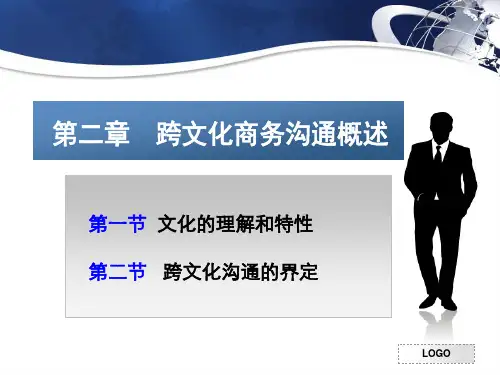
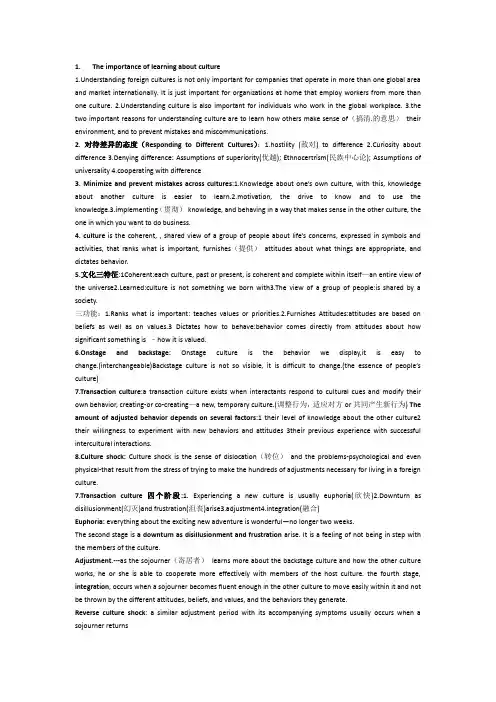
1.The importance of learning about culture1.Understanding foreign cultures is not only important for companies that operate in more than one global area and market internationally. It is just important for organizations at home that employ workers from more than one culture.2.Understanding culture is also important for individuals who work in the global workplace.3.the two important reasons for understanding culture are to learn how others make sense of(搞清.的意思)their environment, and to prevent mistakes and miscommunications.2. 对待差异的态度(Responding to Different Cultures):1.hostility (敌对) to difference 2.Curiosity about difference3.Denying difference: Assumptions of superiority(优越); Ethnocertrism(民族中心论); Assumptions of universality4.cooperating with difference3. Minimize and prevent mistakes across cultures:1.Knowledge about one’s own culture, with this, knowledge about another culture is easier to learn.2.motivation, the drive to know and to use the knowledge.3.implementing(贯彻)knowledge, and behaving in a way that makes sense in the other culture, the one in which you want to do business.4. culture is the coherent, , shared view of a group of people about life’s concerns, expressed in symbols and activities, that ranks what is important, furnishes(提供)attitudes about what things are appropriate, and dictates behavior.5.文化三特征:1Coherent:each culture, past or present, is coherent and complete within itself—an entire view of the universe2.Learned:culture is not something we born with3.The view of a group of people:is shared by a society.三功能:1.Ranks what is important: teaches values or priorities.2.Furnishes Attitudes:attitudes are based on beliefs as well as on values.3 Dictates how to behave:behavior comes directly from attitudes about how significant something is –how it is valued.6.Onstage and backstage:Onstage culture is the behavior we display,it is easy to change.(interchangeable)Backstage culture is not so visible, it is difficult to change.(the essence of people’s culture)7.Transaction culture:a transaction culture exists when interactants respond to cultural cues and modify their own behavior, creating-or co-creating—a new, temporary culture.(调整行为,适应对方or共同产生新行为) The amount of adjusted behavior depends on several factors:1 their level of knowledge about the other culture2 their willingness to experiment with new behaviors and attitudes 3their previous experience with successful intercultural interactions.8.Culture shock:Culture shock is the sense of dislocation(转位)and the problems-psychological and even physical-that result from the stress of trying to make the hundreds of adjustments necessary for living in a foreign culture.7.Transaction culture四个阶段:1. Experiencing a new culture is usually euphoria(欣快)2.Downturn as disillusionment(幻灭)and frustration(沮丧)arise3.adjustment4.integration(融合)Euphoria: everything about the exciting new adventure is wonderful—no longer two weeks.The second stage is a downturn as disillusionment and frustration arise. It is a feeling of not being in step with the members of the culture.Adjustment.---as the sojourner(寄居者)learns more about the backstage culture and how the other culture works, he or she is able to cooperate more effectively with members of the host culture. the fourth stage, integration, occurs when a sojourner becomes fluent enough in the other culture to move easily within it and not be thrown by the different attitudes, beliefs, and values, and the behaviors they generate.Reverse culture shock: a similar adjustment period with its accompanying symptoms usually occurs when a sojourner returnsa9.Self-knowledge and understanding one’s own culture: Having a good understanding of one’s own culture is the best foundation for developing the ability to understand the communication behavior of people from other cultures. To achieve it---Mental representation: use mental categories that hold information items grouped together.10.Mental Representation三个心里表征:prejudice(racism,ageism);bias; discrimination11. Prejudice generalizations that are based on limited knowledge, and that express an evaluation-usually negative-are prejudices.Bias a bias for something is really nothing more than a preference. A bias against something is a negative attitude that ranks it lowDiscrimination when biases or prejudices are acted on, the actor is showing discrimination. Discrimination is the act of sifting(过滤)out and selecting according to bias toward something or someone, and treating them differently.12. Are cultures merging into one global culture? (文化定义;onstage,backstage)13. Approaches to studying cultures:1.focus on a culture as a whole (emic studies一个文化不同层面, etic studies多种文化的共性)2 focus on individual(individuals may have any number of experiences, personal insights, personal goals, interests and expectations that are part of their idetities.14. Emic studiesStudies that concentrate on one culture alone are called emic studies.Etic studiesStudies that look for factors that exist in more than one culture are called etic studies.Cultural generalizationsStudies about whole culture give us conclusions that are generalizations about the culture.15. Cultural dimensionsCharacteristics that could be the basis of comparisons from culture to culture is called cultural dimensions.16. Stereotypes: Stereotyping means using oversimplified generalizations to understand people1stereotypes are fixed, firm, inflexible mental categories2prototypes(原型)are the original concepts or models for something.3nor are all stereotypes bad, some are positive.17. Self-identity: identity is as sth formed in part by the self and in part by group membership.Self-concept can be formed in three general ways.①Social Psychology---experience.②Communication---core symbols, labels and norms.③Critical---social contexts (history, economics, polities, public discourse).18. Self-construal(自我建构) is how we see ourselves in relation to others, with regard to feelings, thoughts, and behavior. In general, western culture have an independent self-construal, and eastern cultures have an interdependent(相互依赖的)self-construal.19. Individualism values individual achievements, failures, and rights over the collective.Collectivism values the group above the individual, and individuals have a responsibility to the group that supersedes(取代)individual needs or rights.20. 文化维度1.语境:a.高High-context cultures rely on the context, either the actual physical environment of communication or an internalized(内在化的)social context, or both, to convey a large part or even all of a message’s meaning. It is elliptical省略的,indirect,allusive(暗指的).低:Low-context cultures entrust(委托)the meaning almost entire the words.it is explicit,direct, completely.2.集体个人a.定义b集体-关系导向型,个人-结果导向型c. A characteristic of individualist culture is competitiveness; the corresponding value in collectivist cultures is cooperation.Collectivism: relationships, old, permanent, public, high power distance (hierarchical), high-context culture, hide emotion, cooperation, harmony, dependence.Individualism:results, youth, temporary, private, low power distance (horizontal), low-context culture, express Emotion, competitiveness, independence.3.权力距离:Power distance is the degree to which less-powerful members of an organization tolerate unequal distribution of power, say, between managers and employees.cultures with a smaller power distance are more horizontal, less hierarchical, and less authoritarian than are cultures with a high power distance.Cultures with high power distance are inequality in power, less horizontal, more hierarchical, and more authoritarian.21. High-context cultures: value relationships, teamwork, and long-term group membership. It rely on subjective information that is internalized (elliptical, indirect, allusive).Low-context cultures: value independent decisions, activity that achieves goals, and individual accountability (explicit, direct, completely).22. High culture refers to those cultural activities that are often the domain of the elite or well-to-do :ballet, sumphony, opera, great literature, and fine art. International; timeless; transcendent(超然的);Low culture refers to the activities of the nonelite: music videos, game shows, professional wrestling, stock car racing, graffiti art, tv talk shows, and so on.23. Where can information about cultures be found: 1. ask people who are members of the culture you want to understand. 2. Another good source may be someone who has spent considerable time in that culture but is not a native member of it.3. You can inquire(询问) into a culture by reading fiction from that culture.4. find out what people of a culture say about themselves. rmation about cultures also comes from studies by anthropologists who research cultures in the field, going to live among the members of the culture they want to understand.24. Does Knowing Come from Concepts or Experience:1.knowing by secondhand information from a reliable source.2.in English-speaking or European cultures, abstract(提取)concepts philosophy arguments reaching back in history.3.knowing and being wise come with age 4.intuition(知觉),meditation(冥想)25. Does Learning Come from Asking Questions or Mastering Received Wisdom:1.In the United States ,students who ask questions are rewarded.2. In many cultures in Asia, Latin America, the Middle East, and Southern Europe, learning means receiving and taking in what is given by teachers.26. Does Knowledge Have Limits:the more you learn, the less you know. E.g. nonscientists who have faith in what science can achieve27. How Do People Reason:1.Western cultures primarily(首先)use a cause-and-effect pattern of thinking.(Linear Logic); two opposite things cannot both be true. 2. Other cultures use other patterns. (Spiral Logic)a. In Asian: thinking is linkage; the opposites co-exist28. Is Doing Important or Is Being Important:1.Doing: western cultures: activity-oriented, peace of life, crowded agendas(日程). 2.Being: stillness, collectedness, serenity(平静), silence(members of doing cultures view silence as waste, members of cultures that value being also often value silence).29. Are Tasks Done Sequentially or Simultaneously:1. performing tasks one-by-one in a sequence 误解disorganized 2. performing multiple tasks simultaneously 误解;inflexible30. Do Results or Relationships Take Priority1.Individulism:a.cause-and-effect,goals-oriented,to make progress (进步). b. identify goals and work toward them c. Strategy to achievement. d. measure how close you have come 2.collectivism:a.relationship-oriented b.Value the relationship as a means to an end.31. Is Uncertainty(不确定性) Avoided or Tolerated:1.uncertainty-averse:Doing:avoid uncertainty, strive toprotect themselves from the unknown 2.uncertaimty-tolerant:Being, tolerant uncertainty; be more open to accepting the unexcepted.32. Is Luck an Essential Factor or an Irrelevance:1. Luck is irrelevant, in cultures that think in cause-and-effect patterns and that value results, planning—not luck—is the key to success. 2. In some cultures, luck or fate or destiny plays a large part, peoples role in achieving success has less effect than forces outside themselves.33. Are Rules to Be Followed or Bent: 1. Followed: neat,predictable behavior, uncertain avoidance(逃避). 2. Bent: flexibility to meet human needs; uncertain(无常的)tolerance.34. Is Change Positive or Negative:1.The culture of the United States thinks of change as desirable and positive. New means better.2.Traditionally, agrarian cultures typically view change is negative. It means disruption(破坏)to the established patterns of life.35. Is Death the End of Life or Part of Life: Some cultures view death as the end of life, a quenching(熄灭)of the light. It is dreaded(令人畏惧的). Some cultures view death as another phase in life, a necessary step in the pattern of life. It is accepted.简36. Relationship between Language and culture:1. culture and language are intertwined(缠绕的) and shape each other. It is impossible to separate the two.2.All languages have social questions and information questions.3. Language reflects the environment in which we live; language reflects cultural values; Sometimes different cultures use identical words that have rather different meanings.37. 不重视语言的问题1.Acronyms(首字母缩略词)2.implication of the language barrier. (字同音不同,异国异含义)38. Selection of the right language: 1. Linguistic Considerations 2. Business Considerations 3. Political Considerations 4. The Appropriate Level of Fluency39. Communication with nonnative speakers: Effective Face-to-Face Communication: a.enunciate b. speak slowly c. Avoid Slang and Colloquialisms(白话)d. Be Careful about Jokes. e. Be Sincere g. Be Culturally Sensitiveh. Keep a Sense of Humor40. Effective Written Communication a. Use Plenty of White Space b. Use Correct Titles and Spellings of Namesc.Understand Patterns of Organizationd. Use Headingse. Be Careful with Numbersf. Be Careful with Datesg. Avoid Abbreviationsh. Follow the Conventions of Written Communication41.技术对沟通的影响:1.telephone;2.skype 3. Email,texting and twitters42. 非语言交流影响因素:1. Cultural background 2.socialeconomic background 3. Education4. Gender 5. Age 6. Personal preferences and idiosyncrasies(特质)43. Paralanguage 1.vocal qualifiers: The term vocal qualifiers refers to volume(音量), pitch(音高), and the overall intonation(声调)or melody(旋律)of the spoken word.2.vocalization: All cultures use nonword noises such as ahem, um, er, sucking in one’s breath, and clicking one’s tongue.44. Nonverbal business conventions:1.eye contact (a sign of honesty/privacy)2. Facial expression(不同文化频率frequency强度intensity不同a. smiling (indicate joy, embarrassment or avoid embarrassment.)b.showing anger(milder form-frowning; hide anger) 3.gesture(head/arm movements; posture) 4.timing in spoken exchanges(an environment that emphasizes equality; seniority and hierarchy;the role of men.)5.touching(people from low-context cultures tend to be feel crowded by people from high-context cultures, and people from high-context cultures feel left out and rejected by people from low-context cultures. 6. The language of space (private/ office/ public space)7.Appearance(a.不同国家穿衣风格不同b.in most cultures, dress also identifies a person as belonging to a specific group and having a certain status.)8.Silence:(高语境文化更倾向于使用沉默,低语境:silence often is interpreted as the absence of communication)45. Signals of respect: it can be different from culture to culture, and it may take some time to learn what isexcepted behavior. Positions of authority Dress as a symbol of authority46权威的象征:1.tone and nguage(indicator)3.Family and societal structures(indicator) Assertiveness(魄力) v.s Harmony.:1.standing up for one’s own rights(individualism,low power distance)2.Preserving harmony(collectivism,high power distance)47绩效的认可及奖励:1.monetary recognition 2.nonmonetary rewards48自我认同1.Self-identity—A Social Psychology Approach:(experiences)we can think about self-concept is that we build up our sense of self from childhood, based on experiences we have had that contribute to our sense of self. 2.Self-identity—A Communication Approach(communication):Identities(身份)are communicated in core symbols, labels, and norms.49.Self-identity—A Critical Approach(social context): The critical approach to self-identity uses history, economics, politics, and public discourse.50 Age: Is Seniority Valued or Discounted: a. In cultures that value age, the older a businessperson is the more credibility he or she has. b. in youth-oriented cultures being young seems to mean having more choices, more power, more energy, and more freedom.51 Gender: Are Women Equals or Subordinates: a.In traditional cultures, the two facts are related. Child-bearing and child-nurturing are the main roles of women. b. management rolea52 Social organization :1 Group Membership: Temporary or Permanent: a. Individuals in the United States are members of many groups simultaneously; group membership is impermanent b. In other cultures, the responsibilities of membership come before rights; group membership is permanent, belonging starts with the family.53 three functions of group communication:1.Give and Save Face 2. Displaywhere individual responsibility, results, and privacy are valued, guilt is a potent way for a culture to enforce(实施)rules of behavior. b. In collectivist cultures where group membership, relationships, and public knowledge of one’s life are important, shame enforces the rules of conduct.)54 form: Important or Untrustworthy(靠不住的): Behaving according to form means behaving correctly.55 Personal Matters: Private or Public: a. In Europe,as in Britain, Canada, the United States, Australia, and New Zealand, a person’s work life is kept fairly separate from private life.b. cultures that emphasize relationships, view group member-ship as long term, and value harmony have a blurred (模糊不清的)distinction(区别)between what is private and what is public (or at least what is “group”).56 Social Organizational Patterns: Horizontal or Hierarchical:1.monarchies(君主制): at one extremeare rigid(严格的)vertical levels in society,2.Democracies: movement between them is very limited; at the other extreme, society is horizontal and operates with few levels.57 Approach to Authority: Direct or Mediated:1. in many cultures, the approach to authority is indirect.2. In New Zealand, in which horizontality has priority, the approach to authority is direct.58 Communicating about problems: 1.in low-context cultures: direct 2.in high-context culture: indirect, put a high priority on keeping harmony, preventing anyone important from losing face, and nurturing relationship.59 Saying no:1.it is done with delay and indirectness in low-context cultures, the rationale(基本原理)is to explain why first. 2.it is more difficult for high-context culture, which is often saying yes.60 Gift giving; 1. in many cultures, it is appropriate to take small gifts when one is invited to enjoy hospitality(好客). 2.the way people from different cultures express appreciation for hospitality varies. 3.the timing of greetings is also important61 Managing conflicts: conflict is a clash between people or between ideas that engages(吸引)people in a struggle against each other. 1. In individualist culture (result-oriented) people are responsible for theconsequence of their own individual activities.2. in collectivist culture(relationship-oriented):they value on relationship, problems are not an individual responsibility.解决方式peting2.collaborating(合作)promising4.avoiding5.accommodating(调节)62.Popular culture refers to those systems or artifacts that most people share and that most people know63 . it's produced by culture industries.it's differs from folk culture.it's everywhere.it's fills a social function.64It differs from folk culture.Popular culture: mass-producedand mass-marketed cultureFolk culture: more authentic "folk" culturea65 CollectivismThink about the family's welfare,reputation,and honor.Marriage and birth-giving, instead of personal affairs, are taken care by all the others in your group which basically is your family.66 IndividualismTakes the marriage as one's own business.Put yourself in the first place thinking of your own happiness, interests67 The concept of face.Concern for face probably appears in many cultures, but is seen as more salient(显著的)for the Chinese than for people from other cultures. Face in Chinese culture refers to one's moral character, a person's reputation or prestige(威望). It is the positive social value that a person claims(主张)for himself by the line others assume he has taken during a particular.68 Chinese culture has three values: face (public esteem); a reciprocal(互惠的)network of connections with others; lasting membership in groups.69 Encoding(编码): the construction of textual meaning by popular culture institution—within specific social context. the process of creating messages for others to understand.70 Decoding: the interpretation of the text’s meaning by receivers— is performed by various audiences in different social contexts. Decoding is the process of interpreting a message.71 Sequentially(循序地) or simultaneously?Some cultures value one who works efficiently as one who accomplishes several things at once. Other cultures value a one-thing-at-a-time approach as the most efficient. 72 Do results or relationships taking priority?Relationship-oriented cultures tend to be collectivistic. The relationships that connect people in networks are more significant than the tasks people accomplish. Results-oriented cultures value the outcomes of actions, especially measurable outcomes, as what matters at work and in life.73 Is obligation a burden or a benefit? Collectivist cultures tend to see it as a benefit to nurturing relationships. Individualist cultures tend to see it as a burden to independence.74 Is social organization horizontal or hierarchical? The general pattern in society also is reflected in companies. Where hierarchy(等级制度) characterizes(具有.特质)the national or social culture, companies also will have a clearly defined corporate ladder(阶梯). The levels are generally agreed upon by members of the collective. In horizontal(水平的)cultures, people can move from their birth level up or down as their individual achievements(业绩)and desires warrant. Mobility(移动性)depends on the accomplishments(成就)of individuals, although their families may partake of(分享)the new status.。
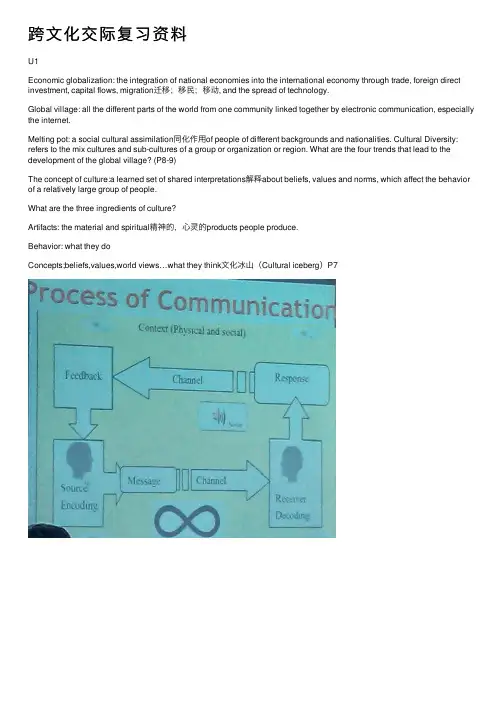
跨⽂化交际复习资料U1Economic globalization: the integration of national economies into the international economy through trade, foreign direct investment, capital flows, migration迁移;移民;移动, and the spread of technology.Global village: all the different parts of the world from one community linked together by electronic communication, especially the internet.Melting pot: a social cultural assimilation同化作⽤of people of different backgrounds and nationalities. Cultural Diversity: refers to the mix cultures and sub-cultures of a group or organization or region. What are the four trends that lead to the development of the global village? (P8-9)The concept of culture:a learned set of shared interpretations解释about beliefs, values and norms, which affect the behavior of a relatively large group of people.What are the three ingredients of culture?Artifacts: the material and spiritual精神的,⼼灵的products people produce.Behavior: what they doConcepts;beliefs,values,world views…what they think⽂化冰⼭(Cultural iceberg)P7Characteristics of cultural:Culture is shared: All communications take place by means of symbols.Cultural is learned: Culture is learned, not inherited. It drives from one?s social communication, not one?s genes. Enculturation(⽂化习得):All the activi ties of learning one?s culture are called enculturation.Culture is dynamic (P6): Culture is subject to change. It?s dynamic动态;动⼒rather than static静态的, constantly不断地;时常地changing and evolving进化;展开under the impact of events and through contract with other cultures.Acculturation(⽂化适应):The process which one adopts the changes brought about by another culture and develops an increased similarity between the two cultures.Culture is ethnocentric(⽂化中⼼主义):Ethnocentric is the belief that your own cultural background is superior. Communication: meaning to share with or to make commotion, as in giving to another a part or share of your thoughts, hopes, and knowledge.Intercultural communication: communication between people whose cultural presumptions假定推定and symbol systems distinct enough to alter the communication event. (P9-10)Components of communication:Source: the source is the person with an idea he or she desires to communicate.Encoding: Encoding is the process of putting an idea into a symbol.Message: the term message identifies the encoded thoughts.Channel: the term channel is used technically to refer to the means by which the encoded message is transmitted.Noise: the term noise technically refers to anything that distorts曲解the message the source encodes. Receiver: the receiver is the person who attends to the message.Decoding: the receiver is actually involved in the communication process by assigning meaning to the symbols received. Receiver response: it refers to anything the receiver does after having attended to and decoded the message. Feedback: it refers to that portion of the receiver responds of the resource has knowledge and to which the source attends and assigns meaning.Context: Generally context can be defined as the environment in which the communication takes place and which helps define the communication.Characters of communication:Communication is dynamic, symbolic, irreversible可逆的, systematic, transactional, and contextual. Unit 2-4 verbal communicationPragmatics⽤学;语⽤论: the study of the effect that language has on human perceptions and behavior. Semantics语义学;语义论: the study of the meaning of words.Denotation符号;表⽰;意义;指⽰: the literal of meaning or definition of a word—theexplicit明确的;清楚的;直率的;详述,particular特别的;详细的;独有的;挑剔的,defined meaning. Connotation暗⽰,隐含意义: the suggestive meaning of a word —all the values, judgments, and beliefs implied by a word, the historical and associative accretion增加物of the unspoken significance意义;重要性;意思behind the literal meaning.Taboo: some objects, words or actions that are avoided by a particular group of people, or in certain culture for religious or social reasons.Euphemism委婉语: the act of substituting取代a mild温和的, indirect间接的, or vague模糊的term for one considered harsh严厉的, blunt⽣硬的, or offensive.How is Chinese addressing different from American addressing? (P22-23)Addressing by names Name order:Surname + given name/He Xiangu Given name + surname (AE)/Linda Smith Nowadays, more and more English-speaking people address others by using the first name, even when people meet for the first time.(P23)In Chinese seniority(资历) is paid respect to. Juniors are supposed address seniors in a proper way. The use of given names is limited by husband and wife, very closely friends, juniors by elders or superiors. Addressing by relationshipChinese often extend kinship terms to people not related by blood or marriage. These terms are used after the surname to shoe politeness and respect. (P23)The English equivalents of the above kinship terms are not so used. Even with relatives, American tends to use just the first name and leave out the term of relationship.Addressing by title, office, professionAnother common Chinese form of address is the use of a person’s title, office or profession to indi cate the person’s influential status. In English, only a few occupations or titles could be used. (P24 Americans tend to regard titles as trivial unless they have a clear idea of what kind of work a person does and what his responsibilities are.Unit 5 nonverbal communicationChronemics: The study of how people perceive and use time.Monochromic time: paying attention to and doing only one thing at a time.Polychromic time: being involved in many things at once.Proxemics: the perception and use to space.Kinetics: the study of body language.Paralanguage: involving sounds but not words and lying verbal and nonverbal communication.Monochromic & Polychromic (P97)Monochromic time means paying attention to doing only one thing at a time.Monochromic time is structured and often rigid. Everything is scheduled down to the minute and precautions are taken to guard against interruption.Polychromic tim e means being involved in many things at once.People and cultures that run on polychromic time multitask well. These people focus on maintaining personal relationships more than completing tasks.Unit 6 cross-gender communicationHow is gender different from sex? (P120) Gender and sex are not synonymousSex: Biological; permanent; individual propertyGender: socially constructed; varied over time and across cultures; social and relational quality.What has influenced the gender socialization? (P121)There are two primary influences on gender socialization: Family communication, particularly between mothers and children and recreational interaction between children.U 7 (P138) High-context culture Low-context culture Unit 9 P186A planetary cultur e: a culture that integrates eastern mysticism with eastern science and relationlism. Intercultural person: represents someone whose cognitive, affective and behavioral characteristics is not limited but open to growth beyond the psychological and parameters of his or her own culture. (P186) What are the Chinese/American cultural values like in terms of Cultural Orientation put forward by Kluckhohn and Strodtbeck?As far as the human nature is concerned, Chinese culture holds that it?s good but corruptible without proper education. As to the relationship of man to nature, they think mankind can live harmony with nature. They also have a cyclical time concept and therefore they are past-oriented. They have a being and becoming attitude and activity and think that man should keep an inner peace as nothing is eternal. They are quite collective and therefore they focus more on the benefit of the group.Identify the features of each of four Hofstede’s cultural dimensions and use them to analyze the cases.Individualism vs. Collectivism Power distance Uncertainty avoidance Masculinity vs. Femininity 每单元练习ABCD(Unit 5 E.Discover the meaning of some common gestures in English. )复习例题1.American parents would ask their children?s opinion in family decision-making because__C__.A.American parents like being told by their children what to do.B.American children have much power in the family.C.American parents take their children as an equal.D.American parents are unable to make decisions themselves.2. What is the best expression of the following you can use when you meet an American friend at the airport? B (P26)A.You must tired.B.Did you have a good trip.B.It is raining, isn?t it?C.Thank you for coming.3. What is a proper response of the following to “Thank you .”? D P57A.It is my duty to do so.B.It doesn?t matter at all.C.I quite understand i t.D.Don?t mention it.4. Which of the following is not one of the characteristic of culture? C P5-11A. It is shared.B. It is learned.C. It is static.D. It is ethnocentric.5. When a British friend is sick, you?d better say “___” to your friend to show your concern.BA.Drink plenty of water. B I do hope you?ll be feeling better soon.C Put on more clothes.D Take medicine on time.6. What is the Chinese equivalent of “landscaper engineer”? D P13A.导游B.伐⽊⼯⼈C.⼯程师D.园林⼯⼈7. What does “call your carriage for you” mean? CA. Ask you for a favorB. Ask you to buy a carriageC. Ask you to go awayD. Ask you to join a party8. Which of the following does not have the sa me function that “副” fulfills in Chinese?D P73A. AssociateB. DeputyC. LieutenantD. Underline9. Which of the following is not included in kinesics? C P95A.PostureB. StanceC. Body distanceD. gesture10. Individualism has the following features except______. AA. strong family tiesB. Self-relianceC. FreedomD. Respect for individual rights11. M-time culture has the following features except______. D P97A. Cutting time into bitsB. Taking deadlines seriouslyC. Scheduling one thing at a timeD. More human-centered12. ____ __culture are typical P-time cultures. A P97A. Latin AmericanB. Northern AmericanC. Western EuropeanD. Northern European13. In American culture, silence may be interpreted as______.D P110A. AssertivenessB. ThoughtfulnessC. EnthusiasmD. Apathy14. Which of the following is not a feature of masculine talk?B P123A. Using talk to assert oneself and one?s ideasB. Being tentative so that others feel free to add their ideasC. Using talk to establish one?s status and powerD. Avoiding personal disclosures15. Which is the following is of the invisible part of cultural iceberg? A P7A. religious beliefsB. gesturesC. eating habitsD. Style of dress16. According to the cultural orientations put forward by Kluckhohn and Strodtbeck, which of the following does not describe the Chinese cultural values? BA.Chinese culture holds that human nature is good but corruptible.B.They have a Linear time concept and are future-oriented.C.They have a being-and-becoming attitude towards activity.D.They are quite collective and focus on the benefits of the group.17. In English-speaking countries, people tend to use all the greetings except______. C P25A.How are you gett ing on?B.How are things?C.Where have you been?D.How?s life?18. What is a proper topic when you are talking with an American? D P26(不确定)A.the price of an itemB. ReligionC. Marital statusD. Hobbies19. Which is the following is of the visible part of the cultural iceberg? B P7A. Religious beliefsB. LiteratureC. ValuesD. Worldviews20. Which of the following is not one of the characteristics of communication? CA. It is symbolicB. It is contextualC. It is staticD. It is systematic21. Which of the following is not one of the social functions of compliments? C P50A. greeting peopleB. starting a conversationC. criticizing peopleD. overcoming embarrassment22. Which of the following is not a feature of sex? B P120A. It is biologicalB.It is dynamicC.It is permanentD.It has an individual property23. What is the Chinese equivalent of sanitation engineer? D P13A. 导游B.伐⽊⼯⼈C.⼯程师D.清洁⼯24. What does the “a lady of the town mean”? C P67(不确定)A. A fashionable girlB. A graceful ladyC. A prostitudeD. An urban girl25. What is the acceptable addressing of “Tom Smith ” in American cuture?D P24A. Teacher SmithB. Mr.TomC. Director TomD.Professor Tom26. The word “dragon” is a word?A P70-71 ( 不确定)A. with different associated meanings in ChineseB. without a counterpart in ChineseC. with the same primary meaning in ChineseD. with many more terms in Chinese27. When making an appointment with an American friend, which of the following expressions is the most appropriate one?D P29A. I?m coming to see you this afternoonB. you must stay at home waiting for me this afternoonC. could you come directly to my house this afternoonD. I was wondering whether I could come round to visit you sometime28. What is the Chinese equivalent of “reckless disregard for the truth”? DA. 躁动不安B.为⾮作⽍C.实事求是D.信⼝雌黄29. Which of the following is not one of the features of gender? C P119-120A. It?s socially-constrictedB. It?s dynamicC. It?s permanentD. It has a relational quality30. Which culture tends to envelop each other in breath when talking? A P101A. Arabian cultureB. American cultureC. British cultureD. Chinese culture31. Which of the following is not included in chronemics? C P95A. punctualityB. time orientationC. silenceD. promptness32. Collectivism emphasizes the following values except BA. strong family tiesB. self-relianceC. harmonyD. group-orientation33. in Japanese culture, silence may be interpreted as evidence of C P110A. passivityB. apathyC. wisdomD. hesitation34. According to the cultural orientations put Forward by Kluckhohn and Strodtbeck, American culture values have the following features except? CA. American culture holds that human nature evil but perfectibleB. They have a linear time concept and are future-orientedC. They have a being-and-becoming attitude towards activiityD. They are quite individualistic35. In English-speaking countries, people tend to use all the greeting except They have a linear time concept and are future-oriented CA. How are you getting on?B. How are things?C. Where are you going?D. How?s life?Cultural Puzzles (3道)1. Katherine came to Beijing in 1998 and found a job as an English teacher in a foreign language institute. Soon after her classes began, she found that her students showed no interest in her teaching and quite a few of them avoided to ask the Director, Prof. Wang, for help. One day, she came to the Director and told him that she would like to talk to him about her problem. The director looked at his timetable and asked if they could meet at ten o?clock on Thursday morning and she agreed.P87This is a typical cultural clash between the Chinese and Westerners, which was caused by their difference regarding_____C .A.Clollectivism vs. IndividualismB. Past-orientation vs. Future-orientationC.P-time vs. M-time D.High-context vs. Low-context2. When an American is parking his bicycle and the bicycle accidentally falls over, he feels embarrassed at his awkwardness, and his quite angered and humiliated when Chinese onlookers laugh.The Chinese onlooker?s laugh may convey the following meaning except____C .A. Don?t take it so seriously.B. It?s nothing.C. You are really clumsy.D. Such things can happen to any of us.3. A Canadian colleague and I traveled to Guilin with our admirable guide Heping Liu in very hot weather. Sight-seeing is thirsty business, we did not trust the water, and delighted in the excellent beer which we politely offered Heping. Heping refused, we said nothing and drank our beer, while poor Heping watched.Q: Why did Heping rufuse the beer on the first offer?A:Because he was being modest and polite.Case Introduction(2道)1. Eric’s different situations in opening the shop in China:He had relatively little difficulty in locating his first shop after several weeks of paperwork, and he was open for business sonner than he had thought possible. The local bureaucrats with whom he dealt had seemed favorably impressed.As Eric began applying for the necessary permits with the local government agencies he was met with responses such as “we …ve never encountered this request”, or” this Procedure requires additional information”.2. Eric’s different attitude:Eric was optimistic about the prospect of his business. His business was quite successful in first few months. People were eager to buy his “unique” product.After several rounds of trying to understand the official rules, Eric beacame increasingly frustrated. After all he had been able to acquire the permits to open shop. Moreover, his attempts to secure additional supply channels were as yet unfruitful. It seemed that all suppliers were “already at full capacity”, or “unsure of future resources”.Case Analysis1.“Doing” orientation: seek to change and control what is happeningEg: He had heard much about the red tape involved in doing business in China but felt he could handle it.2.Collectivisim:A.great readiness to cooperation with in-group membersEg: Chinese are unsure of future resources, and local businessman was announcing the opening of several shops around town.B.collectivists tend to give a higher priority to relationshipsEg: The owners of local businessman had worked through the same government agencies.4. Individualism cultures emphasize competition among individual members to increase productivitywhile collectivist culture stress group harmony and cooperation to chieve efficiencyEg: He wanted to get a jump on his new competition.5. Decision making in a collective culture may be a slower process than in an individualist culture, butthe implementation of the dicision may it be a change in policy.Eg: This procedure requires additional information.Q&A:1.How is Eric?s home culture influence his behavior and his business strategy?A.“Doing” orientatio n—seek to change and control what is happeningEg: He was optimistic./ He heard much about the red tape, but he still felt he could handle it.B.Individualism—coopertate with people who are not members of one?s group plus group membersEg: He had indicated his desire to use local workers and even train local managers.C.Individualism cultures emphasize competition among individual members to increaseproductivity while collectivist culture stress group harmony and cooperation to achieve efficiencyEg: He wanted to get a jump on his new competition.2.What should Eric do to meet his business goals?●He should have an in-depth knowledge of China?s red tape and adapt it gradually.●He should increase the chance of cooperation with Chinese businessmen to coexist peace●When in Rome, do as the Romans do. He can use some Chinese etiquette to expand his network in Chinese society.。
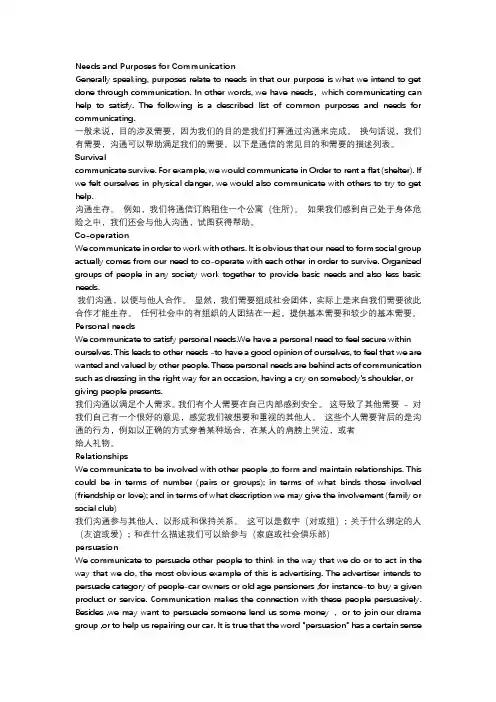
Needs and Purposes for CommunicationGenerally speaking, purposes relate to needs in that our purpose is what we intend to get done through communication. In other words, we have needs,which communicating can help to satisfy. The followingis a described list of common purposes and needs for communicating.一般来说,目的涉及需要,因为我们的目的是我们打算通过沟通来完成。
换句话说,我们有需要,沟通可以帮助满足我们的需要。
以下是通信的常见目的和需要的描述列表。
Survivalcommunicate survive. For example, we would communicate in Order to rent a flat (shelter). If we felt ourselves in physical danger, we would also communicate with others to try to get help.沟通生存。
例如,我们将通信订购租住一个公寓(住所)。
如果我们感到自己处于身体危险之中,我们还会与他人沟通,试图获得帮助。
Co-operationWe communicate in order to work with others. It is obvious that our need to form social group actually comes from our need to co-operate with each other in order to survive. Organized groups of people in any society work together to provide basic needs and also less basic needs.我们沟通,以便与他人合作。

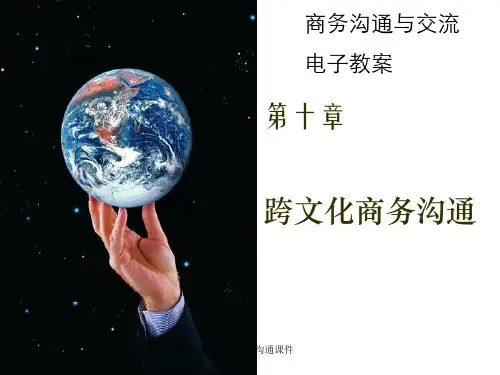

Intercultural communication in English1. Globalization (what & why)1)Dictionary: to organize or establish worldwide2)Wiki: Globalization refers to the increasingly global relationships of culture, people andeconomic activity.3)Globalization refers to the establishment of a world economy, in which national borders arebecoming less and less important as transnational corporations, existing everywhere and nowhere, do business in a global market.4)Globalization refers to “time-spaces compression”. That is, the way in which the worldappears to be getting smaller. (Reasons: the increasing global mobility of people; the impact of new electronic media on human communications)5)At the same time, people all over the world are faced with the same environmental issuesthat affect all cultures.6)Global instability stems from clashes between cultures as humankind createscatastrophes(灾难) that are far worse than natural disasters.7)Culture interdependence: people from different cultures attempt to get along with eachother and try to decrease conflicts.Driving force: technology, particularly telecommunications, computers2. Culture1)People who are raised or live in a particular place probably speak the same language, holdmany of the same values, and communicate in similar ways.2)the group of people who share the same ancestry3)commodities or products that are internationally exported and imported4) a particular way to satisfy our human needs. Maslow: physiological, safety, belongingness,esteem, self-actualization5)The coherent learned, shared view of a group of people about life’s concerns that rankswhat is important, furnishes attitudes about what things are appropriate and dictates behavior.6)Culture is coherent, learned, the view of a group of people, ranks what is important,furnishes attitudes2.1 elements of communication1)Context: the interrelated conditions of communication(aspects: physical settings, historical,psychological, culture)2)Participants: the participants in communication play the roles of sender and receiver,sometimes of the messages simultaneously.3)Messages: elements: meanings, symbols, encoding and decoding.4)Channels: a channel is both the route traveled by the message and the means oftransportation.5)Noise: noise is any stimulus, external or internal to the participants, that interferes with thesharing of meaning. They include: external noise, internal noise, semantic noise6)Feedback: some kind of verbal or nonverbal response3. Different lands, different friendships1)European: friendship is quite sharply distinguished from other, more casual relations, and isdifferently related to family life.2)American: a friendship may be superficial, casual, situational or deep and enduring.3)French: F is one to one relationship that demands a keen awareness of the other person’sintellect, temperament and particular interests; friends generally are of the same sex;disagreement and argument are the breath of live; compartmentalized (a man play chess with a friend for years without knowing his political opinion)4)Germany: F is much more articulately a matter of feeling; friends are brought to the family;disagreement on any subject that matters to both is a tragedy.5)English: F is based on shared activity, and are formed outside the family circle.4. Comparing and contrasting culturesFrederick:Human nature orientation; man-nature orientation; time orientation; activity orientation; social orientationKluckhohns and Strodtbeck:Human nature; relationship of man to nature; sense of time; activity; social relationships4.1Cultural dimensions (Geert Hofstede)Individualism versus collectivismUncertainty avoidancePower distanceMasculinity versus femininityLong-term versus short-term orientation5. High & low context culturesAdding: from wikipediaLow context culture and the contrasting "high context culture" are terms presented by the anthropologist Edward T. Hall in his book Beyond Culture. Low context culture refers to a culture’s tendency not to cater towards in-groups. An "in-group" is defined by the authors as being a discrete group having similar experiences and expectations, from which, in turn, inferences are drawn. Low context cultures, such as Germany or the United States make much less extensive use of such similar experiences and expectations to communicate. Much more is explained through words or verbalization, instead of the context.High context culture and the contrasting "low context culture" are terms presented by the anthropologist Edward T. Hall in his 1976 book Beyond Culture. It refers to a culture's tendency to use high context messages over low context messages in routine communication. This choice of communication styles translates into a culture that will cater to in-groups, an in-group being a group that has similar experiences and expectations, from which inferences are drawn. In a high context culture, many things are left unsaid, letting the culture explain. Words and word choice become very important in higher context communication, since a few words can communicate a complex message very effectively to an in-group (but less effectively outside that group), while in a lower context culture, the communicator needs to be much more explicit and the value of a single word is less important.6. How is language related to culture?1)Culture and language are intertwined and shape each other.2)Culture influences language by way of symbols and rules for using those symbols, as well asour perceptions of the universe.3)All languages have social questions and information questions. The meaning comes out ofthe context, the cultural usage.4)Language reflects cultural values.5)Sometimes different cultures use identical words that have rather different meanings. Theresults can be humorous, annoying, or costly, depending on the circumstances.6)Even if two people from different cultures can speak a common language, they maymisinterpret the cultural signals.7)To summarize, in the culture itself, language-and-culture is embedded in cultural products,practices, perspectives, communities, and persons. One reflects the other, and they are best seem as joined. Language , as a product of culture, is infused with culture.7. The sapir-whort hypothesis8. Nonverbal communication (what)Nonverbal communication is usually understood as the process of communication through sending and receiving wordless,(mostly visual) messages between people. Messages can be communicated through gestures and touch, by body language or posture, by facial expression and eye contact. Nonverbal messages could also be communicated through material exponential; meaning, objects or artifacts (such as clothing, hairstyles or architecture). Speech contains nonverbal elements known as paralanguage, including voice quality, rate, pitch, volume, and speaking style, as well prosodic features such as rhythm, intonation, and stress. Likewise, written texts have nonverbal elements such as handwriting style, spatial arrangement of words, or the physical layout of a page. However, much of the study of nonverbal communication has focused on face-to-face interaction, where it can be classified into three principal areas: environmental conditions where communication takes place, physical characteristics of the communicators, and behaviors of communicators during interaction.I.e. voices, handshakes, hand gestures, eyes movement, face expressions (smile, laugh),touching behaviorIt is governed by culture.Functions: repeating, complementing, substituting, regulating, and contradicting.9. Social timethe peculiarities of the Past-Present-Future in social processes, and their unbreakable connection.10. Improving intercultural communication1)To begin with your own culture, regardless of what that culture might be.2)To identify those attitudes, prejudices, and opinions that we all carry around and that biasthe way the world appears to us.3)To learn to recognize your communication style.Advices:1)Both parties involved in intercultural communication should seek a common language andattempt to understand cultural differences in using the language.2)To develop empathy - be able to see things from the point of view of others so that we canbetter know and adjust to the other people.3)To be flexible when deciding on how to present yourself to another person.。

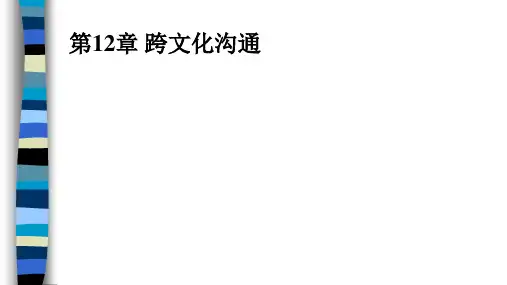
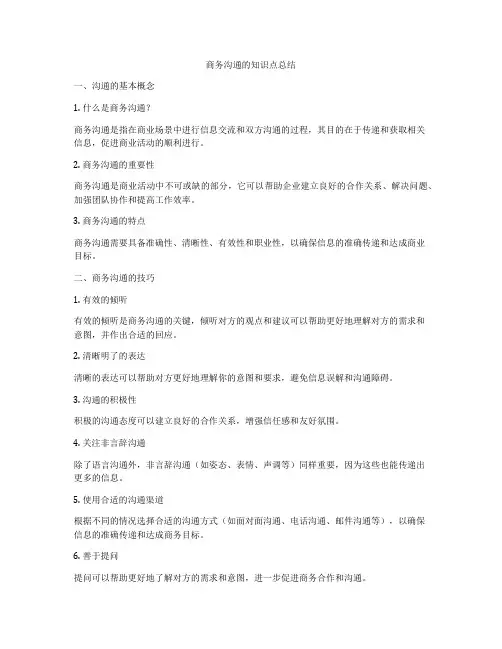
商务沟通的知识点总结一、沟通的基本概念1. 什么是商务沟通?商务沟通是指在商业场景中进行信息交流和双方沟通的过程,其目的在于传递和获取相关信息,促进商业活动的顺利进行。
2. 商务沟通的重要性商务沟通是商业活动中不可或缺的部分,它可以帮助企业建立良好的合作关系、解决问题、加强团队协作和提高工作效率。
3. 商务沟通的特点商务沟通需要具备准确性、清晰性、有效性和职业性,以确保信息的准确传递和达成商业目标。
二、商务沟通的技巧1. 有效的倾听有效的倾听是商务沟通的关键,倾听对方的观点和建议可以帮助更好地理解对方的需求和意图,并作出合适的回应。
2. 清晰明了的表达清晰的表达可以帮助对方更好地理解你的意图和要求,避免信息误解和沟通障碍。
3. 沟通的积极性积极的沟通态度可以建立良好的合作关系,增强信任感和友好氛围。
4. 关注非言辞沟通除了语言沟通外,非言辞沟通(如姿态、表情、声调等)同样重要,因为这些也能传递出更多的信息。
5. 使用合适的沟通渠道根据不同的情况选择合适的沟通方式(如面对面沟通、电话沟通、邮件沟通等),以确保信息的准确传递和达成商务目标。
6. 善于提问提问可以帮助更好地了解对方的需求和意图,进一步促进商务合作和沟通。
7. 不断反馈反馈对方的观点和建议可以帮助了解对方的想法,促进进一步的沟通和合作。
同时,也可以提供自己的反馈,以促进信息的完整性和准确性。
三、商务沟通的常用场景1. 商务会议商务会议是企业内部和外部重要的沟通场景,通过会议可以传递信息、解决问题和制定商业计划。
2. 商务谈判商务谈判是双方就商业合作条件进行协商和讨论的过程,需要双方进行充分的沟通和信息交流,以达成双方满意的合作协议。
3. 商务函电商务函电是商业活动中常见的书面沟通方式,包括信函、邮件、备忘录等,需要用词准确、语气礼貌,并在内容上符合商业礼仪。
4. 商务演讲商务演讲是企业高层向内外部人士发表关于企业发展、战略规划等方面的重要演讲,需要演讲者具备良好的口才和表达能力,以确保信息的准确传达和受众的理解。

跨文化商务沟通整理跨文化商务沟通是指在国际商务中,不同文化背景之间进行有效沟通和交流的能力。
由于全球化的进程加快,不同国家和地区之间的商务交流日益频繁,跨文化商务沟通能力已成为当代商务人士必备的技能之一、在进行跨文化商务沟通时,需要注意以下几个方面:1.学习目标国家的文化特点。
不同国家和地区有不同的文化特点,包括语言、礼仪、价值观等方面。
在进行跨文化商务沟通前,了解目标国家的文化特点是非常重要的,可以避免因为文化差异而造成的误解和冲突。
2.语言表达的准确性和简洁性。
跨文化商务沟通中语言的准确性和简洁性至关重要。
由于语言的语法和习惯用法差异,对于非母语的商务人士来说,可能会出现理解偏差。
因此,在进行商务沟通时,要用简洁明了的语言表达自己的意思,并且尽量避免使用俚语和隐喻。
3.尊重对方的文化差异。
在与其他国家和地区的商务人士交流时,要尊重对方的文化差异,并且不要将自己的文化标准强加给对方。
要理解并接受对方的文化习惯和价值观,避免因为文化碰撞而导致的误解和冲突。
4.了解目标国家的商务礼仪。
不同国家和地区的商务礼仪有差异。
在进行商务交流时,要遵循目标国家的商务礼仪,包括礼貌用语、礼仪习惯等方面。
这样可以给对方留下良好的印象,并且建立良好的商业关系。
5.有效使用非语言交流方式。
除了语言之外,非语言交流方式也是跨文化商务沟通中的重要因素。
例如,姿势、眼神、微笑等非语言表达方式可以传递出商务人士的诚意和友好,有助于建立信任和合作关系。
6.善于倾听和沟通。
在进行跨文化商务沟通时,要善于倾听对方的意见和建议,并且积极参与到对话中去。
通过有效的沟通,可以更好地了解对方的需求和期望,进而实现双方的合作和共赢。
7.避免使用刻板印象和歧视性语言。
在跨文化商务沟通中,要避免使用刻板印象和歧视性语言。
不同国家和地区的文化是多样的,不能因为个别经历或者偏见而对整个国家或地区的人进行评判。
要用平等和尊重的态度对待对方,保持开放的心态,才能建立良好的商业关系。
Intercultural communication in English1. Globalization (what & why)1)Dictionary: to organize or establish worldwide2)Wiki: Globalization refers to the increasingly global relationships of culture, people andeconomic activity.3)Globalization refers to the establishment of a world economy, in which national borders arebecoming less and less important as transnational corporations, existing everywhere and nowhere, do business in a global market.4)Globalization refers to “time-spaces compression”. That is, the way in which the worldappears to be getting smaller. (Reasons: the increasing global mobility of people; the impact of new electronic media on human communications)5)At the same time, people all over the world are faced with the same environmental issuesthat affect all cultures.6)Global instability stems from clashes between cultures as humankind createscatastrophes(灾难) that are far worse than natural disasters.7)Culture interdependence: people from different cultures attempt to get along with eachother and try to decrease conflicts.Driving force: technology, particularly telecommunications, computers2. Culture1)People who are raised or live in a particular place probably speak the same language, holdmany of the same values, and communicate in similar ways.2)the group of people who share the same ancestry3)commodities or products that are internationally exported and imported4) a particular way to satisfy our human needs. Maslow: physiological, safety, belongingness,esteem, self-actualization5)The coherent learned, shared view of a group of people about life’s concerns that rankswhat is important, furnishes attitudes about what things are appropriate and dictates behavior.6)Culture is coherent, learned, the view of a group of people, ranks what is important,furnishes attitudes2.1 elements of communication1)Context: the interrelated conditions of communication(aspects: physical settings, historical,psychological, culture)2)Participants: the participants in communication play the roles of sender and receiver,sometimes of the messages simultaneously.3)Messages: elements: meanings, symbols, encoding and decoding.4)Channels: a channel is both the route traveled by the message and the means oftransportation.5)Noise: noise is any stimulus, external or internal to the participants, that interferes with thesharing of meaning. They include: external noise, internal noise, semantic noise6)Feedback: some kind of verbal or nonverbal response3. Different lands, different friendships1)European: friendship is quite sharply distinguished from other, more casual relations, and isdifferently related to family life.2)American: a friendship may be superficial, casual, situational or deep and enduring.3)French: F is one to one relationship that demands a keen awareness of the other person’sintellect, temperament and particular interests; friends generally are of the same sex;disagreement and argument are the breath of live; compartmentalized (a man play chess with a friend for years without knowing his political opinion)4)Germany: F is much more articulately a matter of feeling; friends are brought to the family;disagreement on any subject that matters to both is a tragedy.5)English: F is based on shared activity, and are formed outside the family circle.4. Comparing and contrasting culturesFrederick:Human nature orientation; man-nature orientation; time orientation; activity orientation; social orientationKluckhohns and Strodtbeck:Human nature; relationship of man to nature; sense of time; activity; social relationships4.1Cultural dimensions (Geert Hofstede)Individualism versus collectivismUncertainty avoidancePower distanceMasculinity versus femininityLong-term versus short-term orientation5. High & low context culturesAdding: from wikipediaLow context culture and the contrasting "high context culture" are terms presented by the anthropologist Edward T. Hall in his book Beyond Culture. Low context culture refers to a culture’s tendency not to cater towards in-groups. An "in-group" is defined by the authors as being a discrete group having similar experiences and expectations, from which, in turn, inferences are drawn. Low context cultures, such as Germany or the United States make much less extensive use of such similar experiences and expectations to communicate. Much more is explained through words or verbalization, instead of the context.High context culture and the contrasting "low context culture" are terms presented by the anthropologist Edward T. Hall in his 1976 book Beyond Culture. It refers to a culture's tendency to use high context messages over low context messages in routine communication. This choice of communication styles translates into a culture that will cater to in-groups, an in-group being a group that has similar experiences and expectations, from which inferences are drawn. In a high context culture, many things are left unsaid, letting the culture explain. Words and word choice become very important in higher context communication, since a few words can communicate a complex message very effectively to an in-group (but less effectively outside that group), while in a lower context culture, the communicator needs to be much more explicit and the value of a single word is less important.6. How is language related to culture?1)Culture and language are intertwined and shape each other.2)Culture influences language by way of symbols and rules for using those symbols, as well asour perceptions of the universe.3)All languages have social questions and information questions. The meaning comes out ofthe context, the cultural usage.4)Language reflects cultural values.5)Sometimes different cultures use identical words that have rather different meanings. Theresults can be humorous, annoying, or costly, depending on the circumstances.6)Even if two people from different cultures can speak a common language, they maymisinterpret the cultural signals.7)To summarize, in the culture itself, language-and-culture is embedded in cultural products,practices, perspectives, communities, and persons. One reflects the other, and they are best seem as joined. Language , as a product of culture, is infused with culture.7. The sapir-whort hypothesis8. Nonverbal communication (what)Nonverbal communication is usually understood as the process of communication through sending and receiving wordless,(mostly visual) messages between people. Messages can be communicated through gestures and touch, by body language or posture, by facial expression and eye contact. Nonverbal messages could also be communicated through material exponential; meaning, objects or artifacts (such as clothing, hairstyles or architecture). Speech contains nonverbal elements known as paralanguage, including voice quality, rate, pitch, volume, and speaking style, as well prosodic features such as rhythm, intonation, and stress. Likewise, written texts have nonverbal elements such as handwriting style, spatial arrangement of words, or the physical layout of a page. However, much of the study of nonverbal communication has focused on face-to-face interaction, where it can be classified into three principal areas: environmental conditions where communication takes place, physical characteristics of the communicators, and behaviors of communicators during interaction.I.e. voices, handshakes, hand gestures, eyes movement, face expressions (smile, laugh),touching behaviorIt is governed by culture.Functions: repeating, complementing, substituting, regulating, and contradicting.9. Social timethe peculiarities of the Past-Present-Future in social processes, and their unbreakable connection.10. Improving intercultural communication1)To begin with your own culture, regardless of what that culture might be.2)To identify those attitudes, prejudices, and opinions that we all carry around and that biasthe way the world appears to us.3)To learn to recognize your communication style.Advices:1)Both parties involved in intercultural communication should seek a common language andattempt to understand cultural differences in using the language.2)To develop empathy - be able to see things from the point of view of others so that we canbetter know and adjust to the other people.3)To be flexible when deciding on how to present yourself to another person.。
Which of following is NOT a nonverbal behavior in people’s communication?选择一项:A. how much one smilesB.the way one sitsC. the telephone messagesD. how much eye contact one makes反馈本句参考译文:下列哪一项不是人类交际中的非言语行为?【知识点来源:Unit 2】本题考查非言语交际的形式。
选项“the telephone messages”(电话信息)是言语交际符号,其他三项都是非言语交际行为:the way one sits(某人的坐姿);how much eye contact one makes(某人有多少目光接触);how much one smiles(某人微笑的多寡),都在交际中传送大量的信息。
正确答案是:the telephone messages评论写评语或修改得分答题历史步骤时间动作状态得分12018年10月22日20:34开始还未回答22018年10月23日22:38保存:the telephone messages 答案已保存32018年10月23日22:59答题结束正确2题目2正确获得2分中的2分未标记题干—These days Mr. Smith looks anxious and restless. What happened?—I heard his wife was in the family way this month.选择一项:A. marriedB. deadC. pregnantD. badly sick反馈本句参考译文:——最近史密斯先生看起来焦虑不安。
他怎么了?——听说他太太这个月刚刚怀孕了。
【知识点来源:Unit 3】本题考查英语单词family的内涵意义。
in the family way 是英语中的习语(idiom),意思是“怀孕”。
跨文化商务沟通复习资料 第一章 一.文化适应的四个维度P9 Dimensions of Acculturation Integration - persons become an integral part of the new culture while maintaining their cultural integrity Separation - individuals keep their culture and stay independent of the new culture Assimilation - persons are absorbed into their new culture and withdraw from their old culture Deculturation - individuals lose their original culture and do not accept the new culture 第二章不作为考试重点 第三章 一.不同文化的人们对待女性,道德标准以及工作的态度不同P47~P56 ①Attitudes Toward Women: Influenced by cultural roots;U.S. women are supposed to have the same rights as men;Kenya women are considered subordinate to men;Gender differences in the U.S. workplace are de-emphasized - women are accepted at higher levels in government and in many companies;U.S. women have taken two-thirds of new jobs created; they are starting new businesses at twice the rate of men;In France, one-fifth of small businesses are owned by women; in Canada, the rate is one-third;The U.S. and Canada lead the world in the number of women in executive positions; Northern and Western Europe, Australia, and New Zealand also have high numbers of women managers. Percentage of Women in Top Management Positions:The Russian Federation 42%,European Union 30%,Australia 23%,United Kingdom 21%,United States 20%,Japan 7%. ②Cultural Attitudes Toward Work: Work ethic - hard work is applauded and rewarded; not working is viewed negatively. U.S. persons value work; executives work -56 hours per week. -take 14 days of vacation a year. European persons work -36 to 41 hours per week. -take 4 to 6 weeks of vacation a year. Europeans:Relaxed;Vacation during month of August;Do not work weekends or holidays (The French take longer vacations than people of any other country.) Australians:Value free time; Value short work week Japanese :Work Monday through Friday, often 18 hours a day;Work until their boss leaves ③Attitudes Toward Ethics: Ethical behavior means acting with integrity, honesty, competence, respect, fairness, trust, courage, and responsibility. Ethical standards are guidelines established to convey what is perceived to be correct or incorrect behavior by most people in a society. Ethics: The Four-Way Test: Is it the truth? Is it fair to all concerned? Will it build goodwill and better friendships? Will it be beneficial to all concerned? 二.个人主义和集体主义P57 Individualism - attitude of valuing ourselves as separate individuals with responsibility for our own destinies and actions. Collectivism - emphasizes common interests, conformity, cooperation, and interdependence. 第四章 一.文化冲击的阶段P69 Stages of Cultural Shock: Stage 1: Excitement and fascination with the new culture; the "honeymoon" stage. Stage 2: Crisis or disenchantment period; excitement has turned to disappointment. Stage 3: Adjustment phase; you begin to accept the new culture, try new foods, see the humor in situations. Stage 4: Acceptance or adaptation phase; feel at home in the new culture and become involved in activities of the culture. Stage 5: Reentry shock; follows the stages identified earlier: initial euphoria, crisis or disenchantment, adjustment, and adaptation. 二.如何缓解文化冲击P71~P74 To alleviate cultural shock, try to see the environment from the perspective of the host nationals. ①慎重挑选外派人员 Alleviating Cultural Shock by Careful Selection of Overseas Personnel(Sensitive, cooperative, able to compromise;Open to others' opinions;Reaction to new situations; appreciation of cultural differences;Understanding of own values and aware-ness of values in other cultures;Reaction to criticism;Understanding government system;Ability to develop contacts in new culture;Patience and resiliency.) ②提供出国前培训 Intellectual or classroom model - involves giving facts about the host country using a variety of instructional methods; Area training or simulation model - emphasizes affective goals, culture specific content, and experiential processes; Self-awareness or human relations model - based on the assumption that the trainee with self-understanding will be more effective in the overseas assignment; Cultural awareness model - emphasizes cultural insight and stresses affective goals and an experiential process; Interaction approach - participants interact with people in the host country; Multidimensional approach - attempts to combine cognitive, affective, and behavioral aspects of training; ③提供反馈和奖励